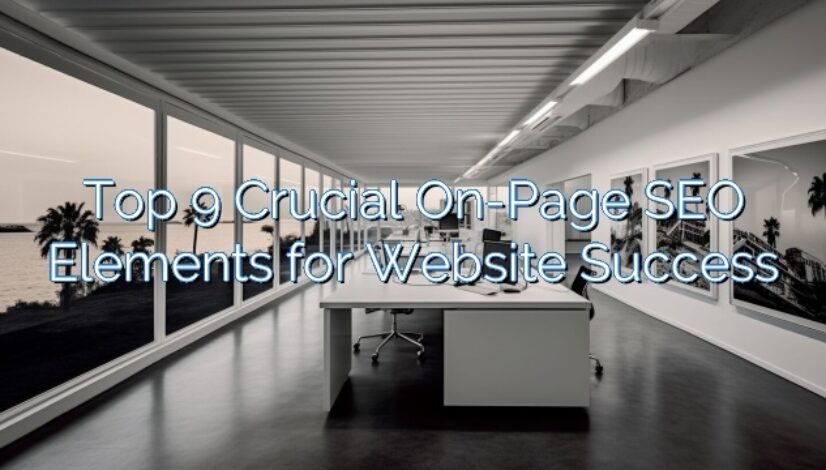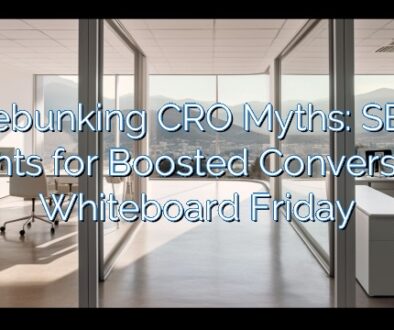Top 9 Crucial On-Page SEO Elements for Website Success
Unlocking the Full Potential of On-Page SEO: A Comprehensive Guide for SMB Owners
As entrepreneurs in the ever-evolving digital arena, we’re all hunting for that competitive edge. And guess what? The golden ticket could be hiding right under your nose, or more accurately, on your website pages. We’re talking about on-page SEO, a fundamental player in the big league that can elevate your site’s visibility like a behind-the-scenes maestro.
Today, let’s dive deep, unravel the on-page SEO mystery, and transform those static pages into dynamic customer magnets. Grab a seat, small business mavens, and let’s decode the digital marketing hieroglyphics together.
Content: The Heartbeat of Your Online Presence
Making Every Word Count for Your Audience
Imagine you’re whipping up the perfect air fryer salmon for dinner. You hop online, search for a recipe, and what do you expect to find? Precisely that—a recipe. Just as diners crave the perfect blend of spices, your website visitors yearn for tailored content that hits the spot. Crafting content that resonates with your audience is not about casting the widest net—it’s about making sure your lure has the perfect bait for the fish you’re trying to catch.
Fulfilling search intent isn’t rocket science; it’s about empathizing with your audience. Probe the corners of their minds, understand their questions, and sculpt your content to offer them the crystal-clear answers they’re after. Remember, relevance is royalty in the kingdom of content creation.
Bringing Content Freshness to the Table
What’s the secret ingredient to keeping your content appetizing? Freshness. No one relishes outdated, stale information. It’s the equivalent of biting into a piece of off-tasting fruit—frustrating and disappointing. Routinely spruce up your content, and you’ll satisfy visitors and search engines alike with delectable, up-to-date morsels of information.
Remain vigilant, keeping your information current and aligned with your users’ quest for knowledge. It’s not just about adding new content, but about nurturing the old to maintain its flavor and relevance.
Title Tags and Meta Descriptions: Your First Impressions Online
Title Tags: Crafting the Perfect Foreword
Your title tag is your virtual handshake—a glance-worthy promise of the value you’re about to deliver. It’s what stands between a user’s fleeting curiosity and their click. Make every character count, keeping it precise yet potent, and watch as it guides users through the serpentine labyrinth of search results to your digital doorstep.
Take a page from Goldilocks: not too long, not too short, but just right, and you’ll have a title tag that both Google and your visitors can’t resist.
Meta Descriptions: The Art of Seduction in 155 Characters
Now, the meta description is where you up the ante—a brief, flirtatious whisper in the cacophony of the internet that convinces searchers to choose you. Just as you’d craft a persuasive elevator pitch, your meta descriptions should entice, intrigue, and promise value, all within a tweet’s length. Do it right, and watch that click-through rate soar.
Think of it as the back of a book cover—it doesn’t tell the whole story but gives just enough to make you want to open the book and read more.
URL and Internal Linking: The Map and Pathways of Your Site
Designing URLs for Clarity and Context
Your URL is the GPS to your online content—a clear, coherent address could mean the difference between a visitor arriving with ease or giving up halfway. Keep URLs descriptive yet succinct, forsaking complexity for user-friendliness, and you’ll not only aid your visitors’ journey but also empower search engines to understand and value your content better.
It’s like naming the streets in a city: the easier they are to navigate, the more likely people are to visit and remember them.
Strategic Internal Linking: Navigating Through Your Digital Ecosystem
Internal links are the connective tissue of your site, guiding visitors from one page to another with purpose and ease. They’re not just about creating a web within your website but about highlighting the journey you want your visitors to take. An intelligent, intentional internal linking strategy will help users and search engines alike find the treasure trove of content you’ve buried within your digital domain.
Imagine a museum with a map and well-placed signs—you want to lead your guests to the exhibits most meaningful to them, encouraging exploration and engagement.
Cutting-Edge Strategies for Visual and Structured Content
Optimizing Images for a Picture-Perfect User Experience
They say a picture is worth a thousand words, but in the online world, that picture could be the difference between a user staying or going. Images on your site need to be more than just eye candy—they should be optimized for speed, accessibility, and SEO. Accurate, keyword-rich alt text, responsive sizing, and smart file format selection can elevate your images from mere decorations to powerful conveyors of story and context.
Visual content can break walls of text, creating breathers that not only add context but enhance engagement—like illustrations in a novel making the story come alive.
Schema Markup: The Invisible Threads Connecting Content and Context
Schema markup is the secret language of search engines, a code whispered between your site and its digitized audience, telling tales of what lies within your pages. When used effectively, schema markup translates your content into rich, detailed stories in the search results—recipes with star ratings, events with dates and locations—making your entries irresistible.
It’s the director’s cut of your movie—a behind-the-scenes glimpse into the depth of your content, allowing users to quantify its value before they even click through.
The Updated E-E-A-T Principle: Your Trust Framework
In the labyrinth of digital information, E-E-A-T stands as a four-pillared temple where trust and quality are worshipped. Experience matters; expertise is revered, authoritativeness is desired, and trustworthiness is the foundation that upholds your content in the eyes of discerning search patrons. In a world rife with misinformation, substantiating your content with the new “E”—evidence of first-hand experience—could tilt Google’s scales in your favor.
Showcase your successes, highlight your hard-earned knowledge, and build content that resonates with authority and reliability. Your audience, and Google, will thank you with their most valuable currency—trust.
The Conclusion: Your SEO Symphony Awaits
There you have it, SMB heroes—on-page SEO isn’t just about playing by the rules; it’s an art form, a strategic game that can catapult your content onto the main stage: Page 1. It’s about weaving a tapestry of relevancy, freshness, clarity, and trust that sings to the algorithms and the heartstrings of your audience.
Ready to unleash the symphony of SEO on your website? Take the next step towards digital dominance; book a 15-minute call with Alex Casteleiro at Nuconet.com. Together, we’ll tune your website’s performance to concert-level perfection. Let’s create your on-page SEO opus!
FAQs: Fine-Tuning Your Understanding of On-Page SEO
What is on-page SEO?
On-page SEO refers to the practice of optimizing individual web pages to rank higher and earn more relevant traffic from search engines. It involves the content, images, HTML tags, URLs, and other elements found directly on the page.
Why are title tags and meta descriptions important?
Title tags and meta descriptions are critical because they serve as a snapshot of what your page is about. They impact click-through rates and play a significant role in helping search engines and users determine the relevancy and value of your content.
Can updating old content really improve my SEO?
Absolutely! Refreshing outdated content can lead to better engagement, reduced bounce rates, and increased organic traffic, as it ensures your visitors find the current and relevant information they seek.
How does internal linking affect my site’s SEO?
Internal linking helps distribute page authority throughout your site, improve navigation for users, and aid search engines in indexing your pages more effectively. Think of it as creating a roadmap for both users and search engines to understand the structure and importance of your content.
What is E-E-A-T and how does it impact my site’s credibility?
E-E-A-T stands for Experience, Expertise, Authoritativeness, and Trustworthiness and adds an additional “E” for evidence of first-hand experience. While not a direct ranking factor, content that demonstrates these qualities can influence how search engines perceive the trustworthiness and relevance of your site.
[ad_2]
Inspiration Source link




